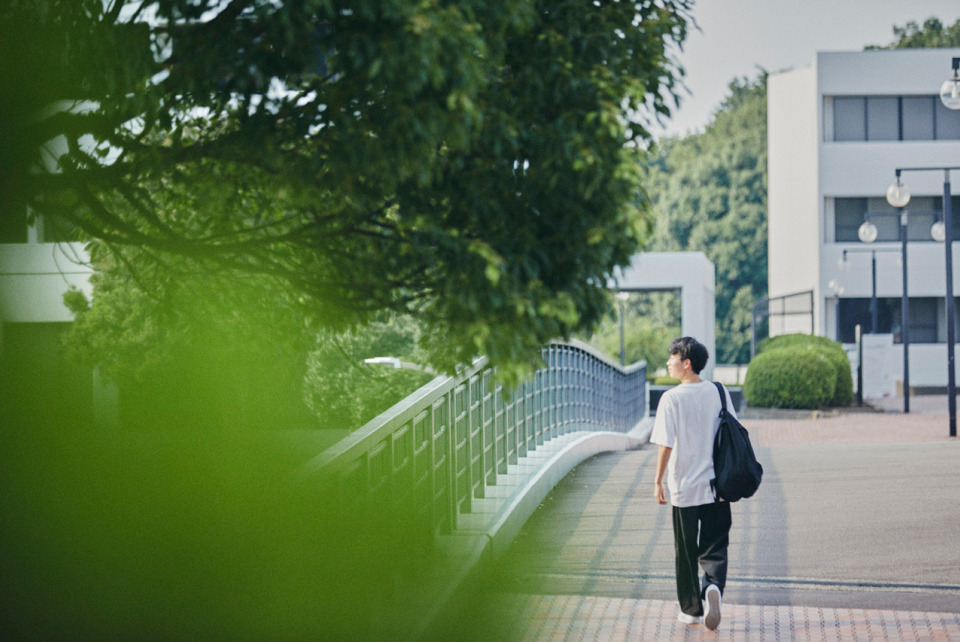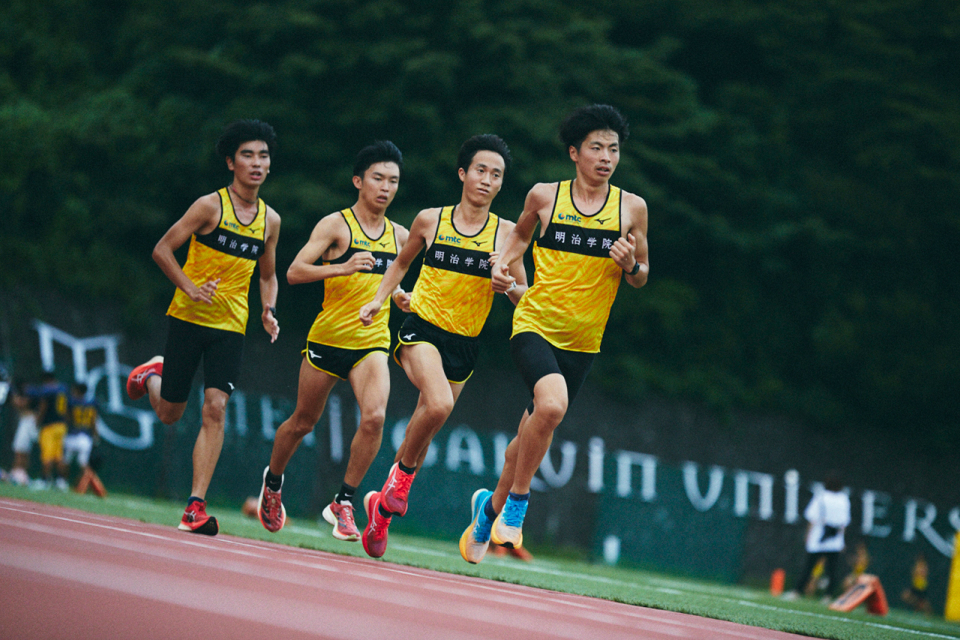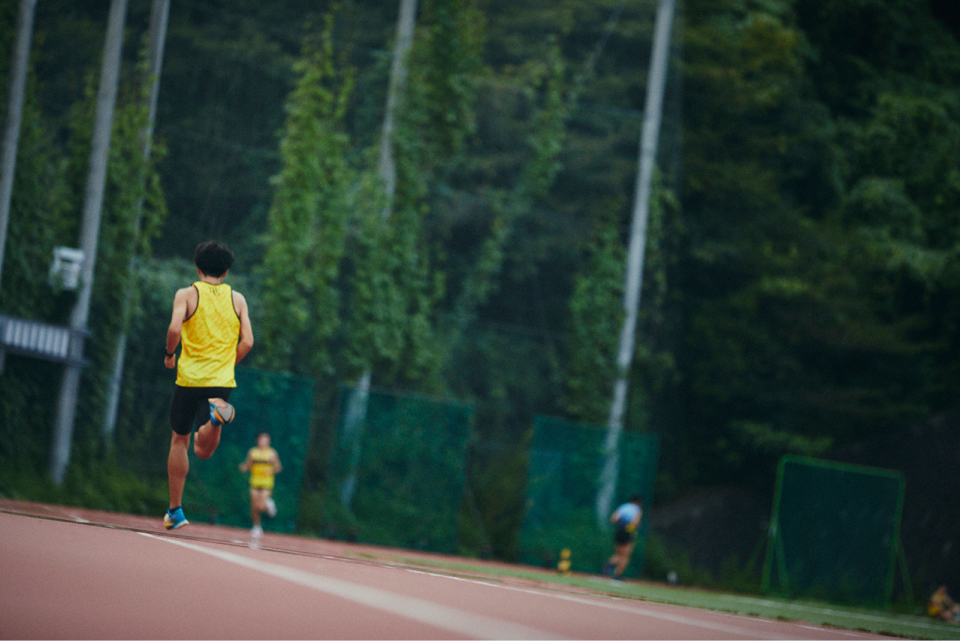-

- Shun Kurihara 4th-year student, Department of Juridical Studies, Faculty of Law A member of the Track and Field Club’s Long-distance division, he holds all of Meiji Gakuin University’s records in the 5000-meter, 10,000-meter, and half-marathon events. He specializes in aggressive running that takes advantage of his speed, and in a June 2024 5000-meter race, he recorded Meiji Gakuin’s first sub-14-minute time (13:58.59). When he isn’t training, he enjoys a bowl of ramen to reward himself after a race. He particularly loves the restaurant Ramen Jiro, and the long time he spends waiting in line is a period of bliss for him.
My long run to Hakone
Shun Kurihara says his track and field career has been a series of setbacks. In 2024, he set new Meiji Gakuin University records in the 5000-meter, 10,000-meter, and half-marathon events. What is the mindset that allows Mr. Kurihara, who aims to participate in the main Hakone Ekiden relay marathon, to recover from adversity? We introduce Mr. Kurihara’s student life so far.

- A childhood obsessed with yachting
- Setbacks when starting track and field
- Never fearing failure and believing in myself as I continued to make efforts
- “Gratitude and Contribution”
- The biggest hurdle in my athletic career
- The 100th Hakone Ekiden preliminaries changed my fate
- Participating in the main race
A childhood obsessed with yachting
Because I grew up near the sea, I was obsessed with yacht racing from elementary to junior high school. The event was titled “sailing,” a competition where you catch the wind with sails and use that power to move across the sea. Although I now spend my days running long distances on land, back then, I spent long hours on the water.
Yachting requires a lot of practice and experience to improve, and repeated failures are not uncommon. However, by steadily accumulating practice, my performance gradually improved, and in junior high school, I had the opportunity to participate in the World Cup in Italy as a junior representative of Japan.
I don’t think I had any special talent for yachting. But through yachting, I gained firsthand experience that not being afraid of failure and believing in myself as I made continued efforts was crucial in reaching my goals. Physically, I needed to strengthen my core body strength to handle the instability of yachts, and I feel that the sense of balance I cultivated during this time has become the foundation for my running style today.

Setbacks when starting track and field
My first encounter with track and field was in sixth grade, when I participated in the 1000-meter event in a city-sponsored track and field meet. I produced unremarkable results, but I remember feeling exhilarated by running and being moved by the sensation of cutting through the wind. This experience led me to join my junior high school’s track and field club. Initially, I mainly practiced sprinting, but I switched to long-distance running at my advisor’s recommendation.
From that point on, however, I experienced a series of setbacks. Despite accumulating practice, I couldn’t produce results in competitions, and ultimately, I didn’t even make it past city-level competitions throughout junior high school. Naturally, no high schools approached me for track and field, so I ended up enrolling in a high school that had a good atmosphere when I visited for an open house event.
Never fearing failure and believing in myself as I continued to make efforts
I intended to try something new in high school, but the high school I entered happened to have a powerhouse track and field team. I had no intention of continuing track, but after an invitation from a friend who had joined the track team, a trial participation somehow led to my joining the team. Of course, there was no dramatic turn of events where my abilities suddenly blossomed; there, too, my days of lackluster results continued. Being one of the top schools in the prefecture, there was such a large gap in ability between myself and others that my teammates started to wonder if I would quit before summer.
For the first year after entering high school, I was the slowest runner on the team, and there were many times when I felt close to heartbreak. Strangely, though, I never came to dislike track and field. As I continued practicing without becoming discouraged, my seniors began accompanying me on morning group runs, giving me advice on running and consulting with me about lifestyle matters. As communication with my seniors deepened trust within the team, my running naturally improved. In my third year of high school, I felt a potential I had never experienced before, but COVID-19 led to all major competitions being cancelled, and my high school life ended without the opportunity to demonstrate my true abilities.

“Gratitude and Contribution”
I learned about Meiji Gakuin University when a senior from my high school track team enrolled there. I strongly desired to participate in the Hakone Ekiden marathon while at university, and I considered going to a school known for its strong track program. However, I believed my success so far was possible only because of my connections with the many people who had supported me. I wanted to remember that feeling of gratitude and, in turn, support other team members myself. I thus wanted to enroll in a university that would respect this way of thinking.
The slogan of Meiji Gakuin’s track team is “Gratitude and Contribution,” and that aligned with my personal philosophy. Moreover, I learned that under the guidance of excellent coaches, they conduct activities that respect students’ autonomy. I was convinced that this was an environment in which I could grow both as an athlete and as a person, guiding my decision to enroll at Meiji Gakuin University.
The reason I wanted to join the Faculty of Law’s Department of Juridical Studies was that through the study of law, I wanted to acquire knowledge necessary as a working adult and to develop rational thinking and problem-solving skills. Since I wasn’t aspiring to become a legal professional, I was also attracted to the fact that the department has a system that allows students to choose courses according to their future career paths and interests.
The biggest hurdle in my athletic career
After enrolling at Meiji Gakuin, I naturally joined the Track and Field Club’s Long-distance division and devoted my days to classes and club activities. My seniors at the time were very approachable, and there wasn’t a strict hierarchy like that often seen in school clubs. Our relationship allowed us to share opinions on equal footing and organize our practice environment while thinking for ourselves. That was comfortable for me and helped me improve my track performance.
However, just as my performance was improving and expectations were building that I would become a key team member, I faced another major obstacle: aerophagia, which had started troubling me in my second year at university. Aerophagia is a condition in which air accumulates in the stomach and cannot be adequately expelled, making breathing difficult. My symptoms would appear at times of high tension and were particularly severe during the 99th Hakone Ekiden preliminaries in my second year. Around the latter half of that run, my body stopped moving, resulting in my retirement from the race. Feeling that I had let everyone down in an important race, I was crushed and thought my athletic career was over.
However, it was my track team members who supported me at that lowest point of my life. They treated me the same as usual the next day, standing by me without even mentioning what had happened, which was a great comfort to me. I felt that Meiji Gakuin’s educational philosophy of “Do for Others” and the track team’s motto of “Gratitude and Contribution” were not just superficial words, but principles that were alive at this school. That left me reassured, and strongly feeling that next time, I absolutely wanted to be the one supporting the team.

The 100th Hakone Ekiden preliminaries changed my fate
My aerophagia symptoms gradually improved with each practice and competition, and a significant turning point came during the 100th Hakone Ekiden preliminaries in my third year. With determination to believe in myself and my continued efforts without fearing failure, I approached the race intending to pull off an aggressive race development. I managed to stick with the leading group of Japanese runners up to the 10-kilometer mark, passing it in 29 minutes and 20 seconds: over a minute and a half faster than my personal best. Even then, I still had reserve energy in my legs and felt like I could run indefinitely. This experience allowed me to reassess my limits, and I felt like I’d broken through some thick shell. I believe that being able to adopt a mindset of enjoying the challenge of pushing my limits without deciding “this is as far as I can go” led to my subsequent Meiji Gakuin records.
Participating in the main race
Currently, I’m thinking of nothing but securing Meiji Gakuin University’s first-ever team participation in the main race at the 101st Hakone Ekiden preliminaries, to be held on October 19, 2024. I sincerely hope that many people will come to cheer for us in person and witness a heart-stirring run by the Meiji Gakuin track team.
I plan to continue competing even after graduation. Through my love of track and field, I want to see how much I can grow and confirm my further potential. I sincerely hope that by continuing to run, I can someday repay Meiji Gakuin University, which has provided me with many growth opportunities.

